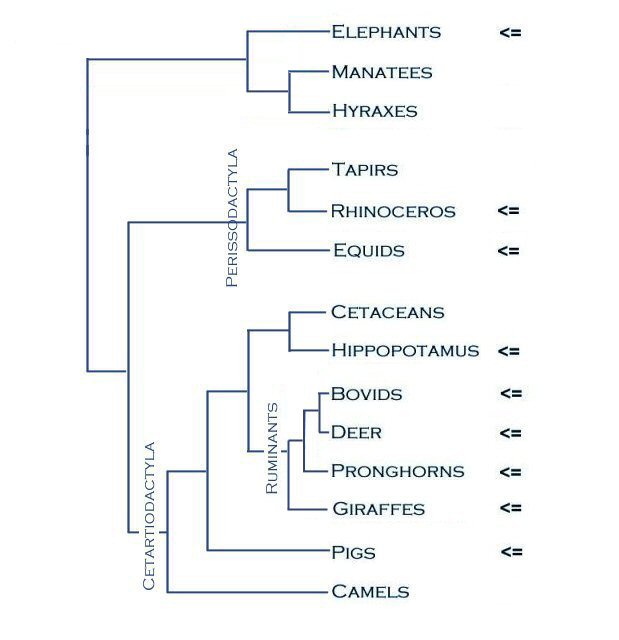The ungulates and their relatives are a
puzzling group, including animals as diverse as whales and hippos, elephants
and hyraxes, horses and tapirs, giraffes and sheep. What they have in
common is that many of them walk around on their toenails. The phylogeny
(family relationships) of the ungulates is a constantly shifting terrain, but
genetic analysis is beginning to help sort out this enigmatic group of
animals. At WhoZoo, elephants,
hippos and rhinos have been grouped for convenience as "large
herbivores," but this is an artifical grouping; these animals actually
represent three different branches of hooved animals. The simplified
family tree below is redrawn from the cladograms and other information at the
University of California
Museum of Paleontology Web Site and from an article on mammalian phylogeny
in Nature (1 February 2001).
The three main branches of the tree below are the
Cetartiodactyla, the Perissodactyla and a part of the recently defined
Superorder Afrotheria, which includes the Orders Proboscidea (elephants),
Sirenia (manatees and sea cows) and Hyracoidea (hyraxes). In the
Perissodactyla, the major axis of the leg lines up with the middle toe (the
third digit), while in the hooved members of the Cetartiodactyla, this axis
falls between two toes (the third and fourth digits). Because of molecular
evidence that indicates similarities between hippos and whales, the Order
Cetartiodactyla combines two former orders: the Cetacea (whales and dolphins)
and the Artiodactyla. The Ruminants are a large and successful subgroup of the
Cetartiodactyla with complex stomachs and the habit of chewing a cud -- a chunk
of food that has been swallowed once and then brought back up into the mouth
for additional processing. Of the ruminants, the Bovids constitute
the largest and most diverse group, including cattle, antelope, sheep and
goats. Pointers indicate taxa with representatives at the Fort Worth Zoo. For
groups including animals with an informational page or a picture at WhoZoo,
there is a link from the group name to one representative of the group.
